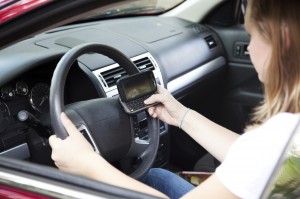Plus: The Importance of Parents Setting a Good Example
Despite the fact that all motorists are aware of the dangers of talking or texting on a cell phone while driving, many Americans continue to engage in the practice. And teenagers are no exception.
A new study has found that the vast majority of American teenagers use their cell phones to talk or text while they drive, and about half the time, when teens talk on their mobile phones as they drive, they are talking to their parents!
Psychologists in Petaluma, CA, who conducted the study, point out that children — including teenagers — tend to copy parental behavior; parents can talk to kids, but ultimately, children are more likely to do as their parents do. So, if teens see their own parents or family friends using cell phones while driving, the youths are more apt to do so themselves.
The Tragic Statistics of Distracted Driving
Motor vehicle crashes are the leading cause of death for teenagers in the United States, according to the Centers for Disease Control and Prevention. For every mile driven, teenage drivers are three times more likely to die in auto accidents than drivers 20 and older.
Approximately 2,700 teenagers, ages 16 to 19, are killed every year in the U. S. in auto accidents where a teen was behind the wheel.
Distracted driving is to blame in 11 percent of these fatal accidents (speeding is involved in close to 40 percent). In 21 percent of those distraction-related crashes, the teenager was using a cell phone while he or she drove. (Source: 2013 report by the National Highway Traffic Safety Administration.)
Researchers in the Petaluma study interviewed about 400 drivers between ages 15 and 18 in 31 states.
The younger teens with learner’s permits were the least likely to use cell phones while driving, as 43 percent didn’t have phones. But by the time 16- and 17-year-olds had unrestricted driver’s licenses, a whopping 71 percent stated that they used cell phones while driving. By age 18, 90 percent said they used cell phones while they drove.
All teens who said that they talked on the phone while driving said that they talked to their parents on the phones; 20 percent said they talked to friends.
The percentages of teenagers who texted while driving were lower than those of teens who talked on the phones, although the numbers were still high. About two-thirds of teens with learner’s permits did not text while driving; but by the time the teens were fully licensed and had reached age 18, close to 75 percent acknowledged texting while driving.
Setting Rules for When Your Teenager Can Talk on the Cell Phone
It is important for parents to establish rules for cell phone use by teens. Many of the teenagers in the study reported that their parents expected to be able to reach the teens when the parents called. It is understandable that a parent would want to have the ability to communicate with their child while the child is away from home.
These are strategies that parents can try:
- Before your teen leaves the home, agree on an approximate time or times when he or she is to call you
- Instruct your child to let the phone ring, if they’re driving when you call, and to pull in somewhere and call you back within a reasonable time, like 5 to 15 minutes
- Model safe driving behavior for your teenager, to include not using a cell phone to talk or text while driving
- Talk to your child about how potentially dangerous motor vehicles are, what a big responsibility they are, and bring up the topic that many people of all ages, including teenagers, die every year in the United States from distracted (and reckless) driving
Of course, using a cell phone while driving is only one of a number of risks that can end in catastrophe while on the road. The following are some other points you should discuss with your teenage driver.
The importance of safe-driving practices learned about in driver’s education class, including: always wearing a seat belt; leaving a safe distance between your child’s car and the car in front; obeying speed limits and never speeding; being alert to all traffic signs, traffic lights and stop signs; avoiding hazardous driving conditions, such as driving in the rain or snow (speed should be decreased when it’s raining, and snow should only be driven on with snow tires or chains)
Other factors that pose a higher risk of vehicle crashes for teenagers:
- Male teen drivers and male passengers are involved in fatal auto accidents almost twice as often as female teens
- Teens driving with teen passengers have a greater risk of crashing; the more passengers, the higher the risk
- Male teens driving with male teen passengers engage more often in speeding and following cars too closely (“tailgating”)
- Crash risk is especially high during the first months after a teenager is licensed
- At all levels of blood alcohol concentration (BAC), teenage drivers have a greater risk of being in a crash than older drivers
(Source for above risk factors: CDC.)
By Marc Courtiol

Leave a Reply